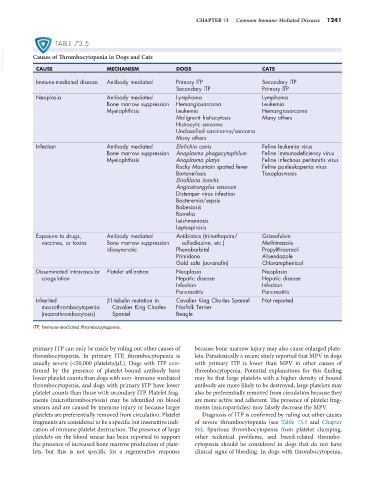Page 1269 - Small Animal Internal Medicine, 6th Edition
P. 1269
CHAPTER 73 Common Immune-Mediated Diseases 1241
TABLE 73.5
VetBooks.ir Causes of Thrombocytopenia in Dogs and Cats DOGS CATS
CAUSE
MECHANISM
Immune-mediated disease Antibody mediated Primary ITP Secondary ITP
Secondary ITP Primary ITP
Neoplasia Antibody mediated Lymphoma Lymphoma
Bone marrow suppression Hemangiosarcoma Leukemia
Myelophthisis Leukemia Hemangiosarcoma
Malignant histiocytosis Many others
Histiocytic sarcoma
Unclassified carcinoma/sarcoma
Many others
Infection Antibody mediated Ehrlichia canis Feline leukemia virus
Bone marrow suppression Anaplasma phagocytophilum Feline immunodeficiency virus
Myelophthisis Anaplasma platys Feline infectious peritonitis virus
Rocky Mountain spotted fever Feline panleukopenia virus
Bartonellosis Toxoplasmosis
Dirofilaria immitis
Angiostrongylus vasorum
Distemper virus infection
Bacteremia/sepsis
Babesiosis
Borrelia
Leishmaniasis
Leptospirosis
Exposure to drugs, Antibody mediated Antibiotics (trimethoprim/ Griseofulvin
vaccines, or toxins Bone marrow suppression sulfadiazine, etc.) Methimazole
Idiosyncratic Phenobarbital Propylthiouracil
Primidone Albendazole
Gold salts (auranofin) Chloramphenicol
Disseminated intravascular Platelet utilization Neoplasia Neoplasia
coagulation Hepatic disease Hepatic disease
Infection Infection
Pancreatitis Pancreatitis
Inherited β1-tubulin mutation in Cavalier King Charles Spaniel Not reported
macrothrombocytopenia Cavalier King Charles Norfolk Terrier
(macrothrombocytosis) Spaniel Beagle
ITP, Immune-mediated thrombocytopenia.
primary ITP can only be made by ruling out other causes of because bone marrow injury may also cause enlarged plate-
thrombocytopenia. In primary ITP, thrombocytopenia is lets. Paradoxically a recent study reported that MPV in dogs
usually severe (<50,000 platelets/µL). Dogs with ITP con- with primary ITP is lower than MPV in other causes of
firmed by the presence of platelet-bound antibody have thrombocytopenia. Potential explanations for this finding
lower platelet counts than dogs with non–immune-mediated may be that large platelets with a higher density of bound
thrombocytopenia, and dogs with primary ITP have lower antibody are more likely to be destroyed; large platelets may
platelet counts than those with secondary ITP. Platelet frag- also be preferentially removed from circulation because they
ments (microthrombocytosis) may be identified on blood are more active and adherent. The presence of platelet frag-
smears and are caused by immune injury or because larger ments (microparticles) may falsely decrease the MPV.
platelets are preferentially removed from circulation. Platelet Diagnosis of ITP is confirmed by ruling out other causes
fragments are considered to be a specific but insensitive indi- of severe thrombocytopenia (see Table 73.5 and Chapter
cation of immune platelet destruction. The presence of large 86). Spurious thrombocytopenia from platelet clumping,
platelets on the blood smear has been reported to support other technical problems, and breed-related thrombo-
the presence of increased bone marrow production of plate- cytopenia should be considered in dogs that do not have
lets, but this is not specific for a regenerative response clinical signs of bleeding. In dogs with thrombocytopenia,

